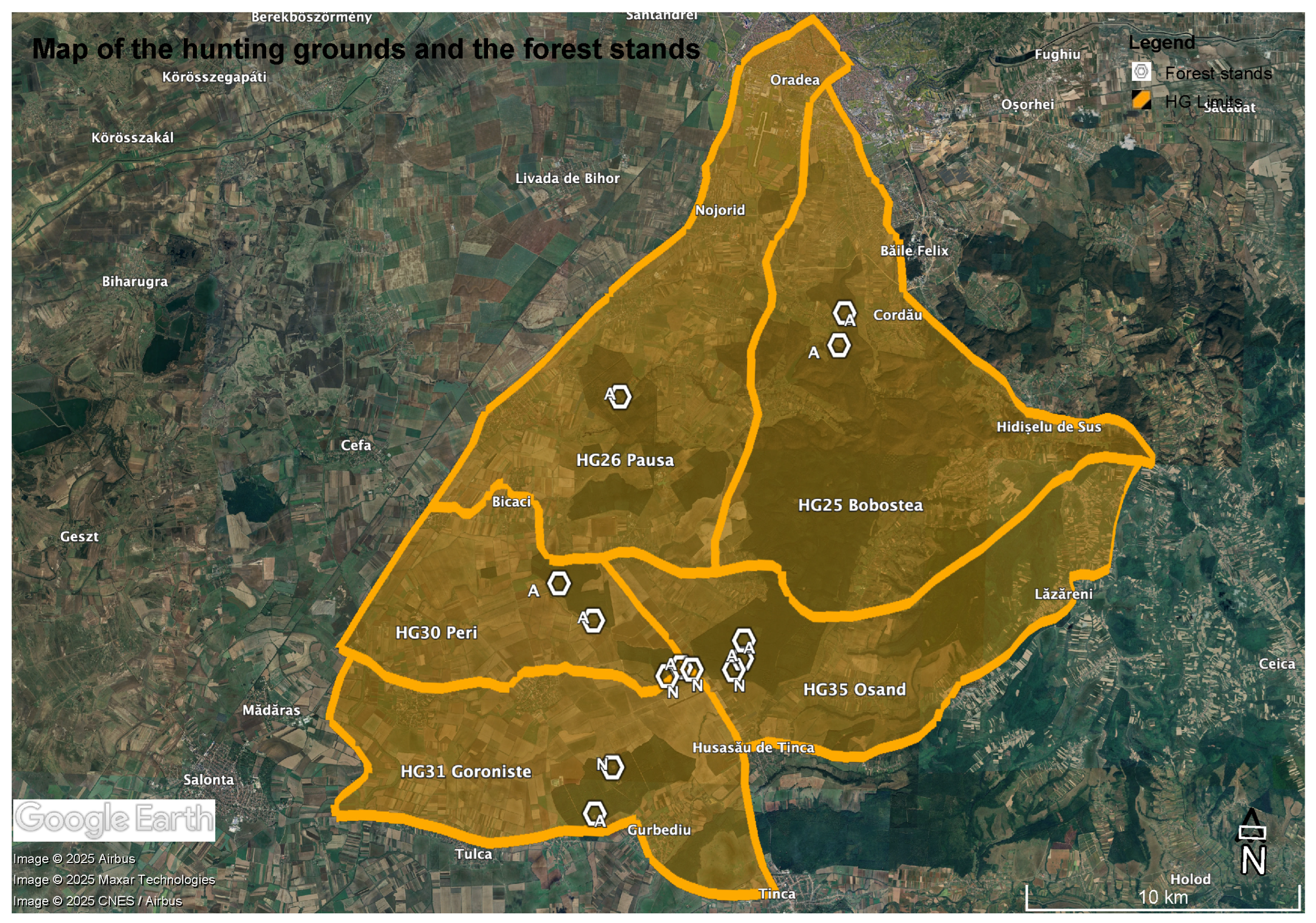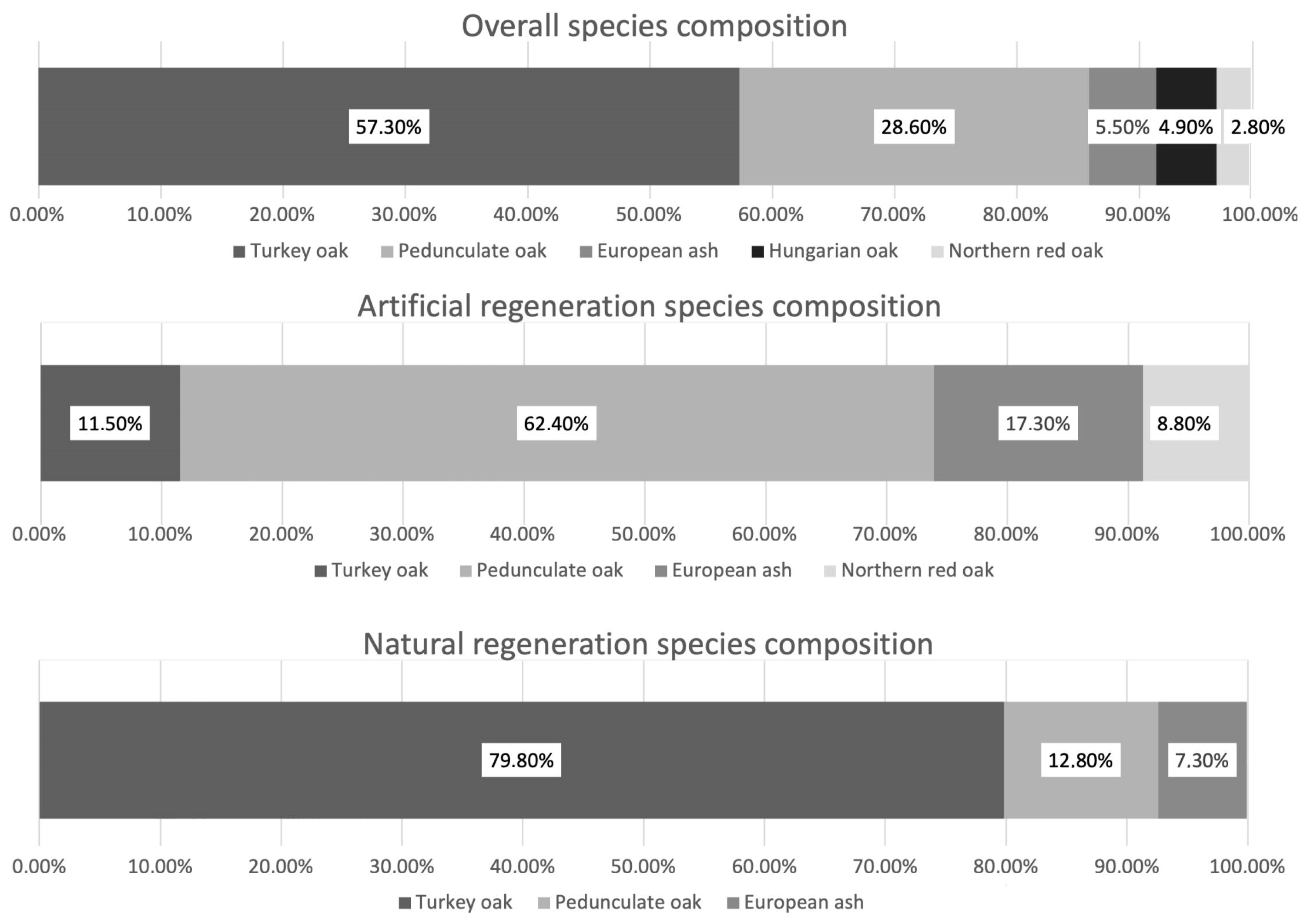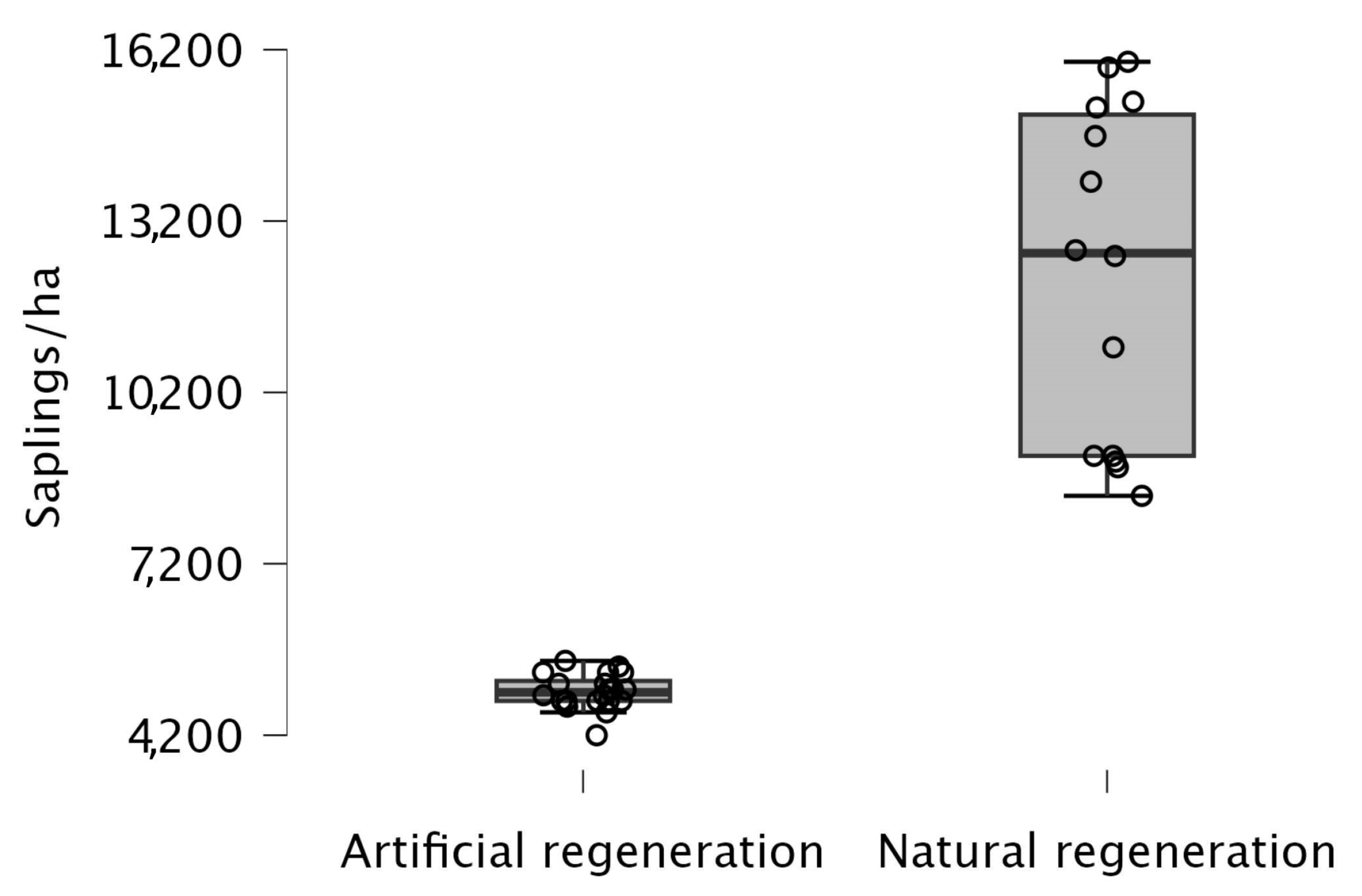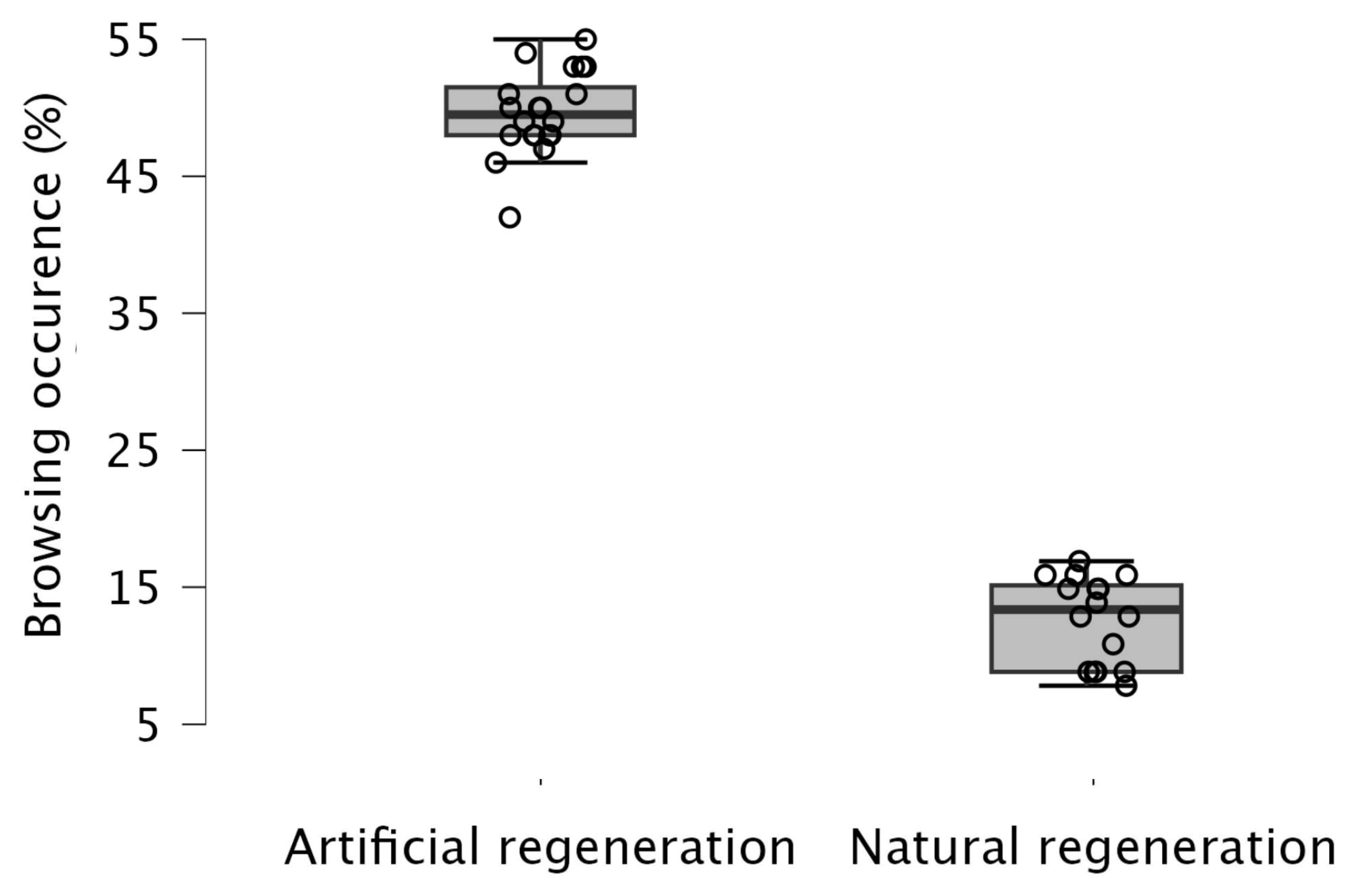Insights in Managing Ungulates Population and Forest Sustainability in Romania
Abstract
1. Introduction
2. Materials and Methods
2.1. Study Area
2.2. Sampling Design and Data Collection
2.3. Statistical Analysis
3. Results
3.1. Regeneration and Browsing Characteristics
3.2. Occurrence of Ungulate Browsing
3.3. Ecosystem Supportability
4. Discussion
5. Conclusions
Author Contributions
Funding
Institutional Review Board Statement
Data Availability Statement
Acknowledgments
Conflicts of Interest
References
- Hunault-Fontbonne, J.; Eyvindson, K. Bridging the gap between forest planning and ecology in biodiversity forecasts: A review. Ecol. Indic. 2023, 154, 110620. [Google Scholar] [CrossRef]
- Sample, V.A. Sustainable forestry and biodiversity conservation toward a new consensus. J. Sustain. For. 2006, 21, 137–150. [Google Scholar] [CrossRef]
- Brockerhoff, E.G.; Barbaro, L.; Castagneyrol, B.; Forrester, D.I.; Gardiner, B.; González-Olabarria, J.R.; Lyver, P.O.; Meurisse, N.; Oxbrough, A.; Taki, H.; et al. Forest biodiversity, ecosystem functioning and the provision of ecosystem services. Biodivers. Conserv. 2017, 26, 3005–3035. [Google Scholar] [CrossRef]
- Putman, R. Ungulates in temperate forest ecosystems: Perspectives and recommendations for future research. For. Ecol. Manag. 1996, 88, 205–214. [Google Scholar] [CrossRef]
- Putman, R.; Apollonio, M.; Andersen, R.; Reimoser, F. Impacts of wild ungulate on vegetation: Cost and benefits. In Ungulate Management in Europe: Problems and Practices; Cambridge University Press: Cambridge, UK, 2011. [Google Scholar]
- Carpio, A.J.; Apollonio, M.; Acevedo, P. Wild ungulate overabundance in Europe: Contexts, causes, monitoring and management recommendations. Mamm. Rev. 2021, 51, 95–108. [Google Scholar] [CrossRef]
- Apollonio, M.; Andersen, R.; Putman, R. European Ungulates and Their Management in the 21st Century; Cambridge University Press: Cambridge, UK, 2010. [Google Scholar]
- Putman, R.; Apollonio, M.; Andersen, R. Ungulate Management in Europe: Problems and Practices; Cambridge University Press: Cambridge, UK, 2013. [Google Scholar]
- Malpeli, K.C. Ungulate Migration in a Changing Climate—An Initial Assessment of Climate Impacts, Management Priorities, and Science Needs; U.S. Geological Survey: Reston, VA, USA, 2022. [Google Scholar]
- Mysterud, A.; Sæther, B.-E. Climate change and implications for the future distribution and management of ungulates in Europe. In Ungulate Management in Europe; Cambridge University Press: Cambridge, UK, 2011; pp. 349–375. [Google Scholar]
- Gill, R.M.A. A Review of Damage by Mammals in North Temperate Forests: 3. Impact on Trees and Forests. For. Int. J. For. Res. 1992, 65, 363–388. [Google Scholar] [CrossRef]
- Gill, R.M.A. A Review of Damage by Mammals in North Temperate Forests: 1. Deer. For. Int. J. For. Res. 1992, 65, 145–169. [Google Scholar] [CrossRef]
- Hardalau, D.; Codrean, C.; Iordache, D.; Fedorca, M.; Ionescu, O. The Expanding Thread of Ungulate Browsing—A Review of Forest Ecosystem Effects and Management Approaches in Europe. Forests 2024, 15, 1311. [Google Scholar] [CrossRef]
- Reimoser, F.; Reimoser, S.; Zsak, K. Long-term impact of wild ungulates on natural forest regeneration in the Donau-Auen National Park, Austria. Acta Zoobot Austria 2022, 158, 97–127. [Google Scholar]
- Unkule, M.; Piedallu, C.; Balandier, P.; Courbaud, B. Climate and ungulate browsing impair regeneration dynamics in spruce-fir-beech forests in the French Alps. Ann. For. Sci. 2022, 79, 11. [Google Scholar] [CrossRef]
- Motta, R. Wild ungulate browsing, natural regeneration and silviculture in the Italian alps. J. Sustain. For. 1998, 8, 35–53. [Google Scholar] [CrossRef]
- Bernard, M.; Boulanger, V.; Dupouey, J.-L.; Laurent, L.; Montpied, P.; Morin, X.; Picard, J.-F.; Saïd, S. Deer browsing promotes Norway spruce at the expense of silver fir in the forest regeneration phase. For. Ecol. Manag. 2017, 400, 269–277. [Google Scholar] [CrossRef]
- Heuze, P.; Schnitzler, A.; Klein, F. Is browsing the major factor of silver fir decline in the Vosges Mountains of France? For. Ecol. Manag. 2005, 217, 219–228. [Google Scholar] [CrossRef]
- Diaci, J. Regeneration dynamics in a Norway spruce plantation on a silver fir-beech forest site in the Slovenian Alps. For. Ecol. Manag. 2001, 161, 27–38. [Google Scholar] [CrossRef]
- D’aprile, D.; Vacchiano, G.; Meloni, F.; Garbarino, M.; Motta, R.; Ducoli, V.; Partel, P. Effects of Twenty Years of Ungulate Browsing on Forest Regeneration at Paneveggio Reserve, Italy. Forests 2020, 11, 612. [Google Scholar] [CrossRef]
- Rozman, A.; Diaci, J.; Krese, A.; Fidej, G.; Rozenbergar, D. Forest regeneration dynamics following bark beetle outbreak in Norway spruce stands: Influence of meso-relief, forest edge distance and deer browsing. For. Ecol. Manag. 2015, 353, 196–207. [Google Scholar] [CrossRef]
- Shifley, S.R.; Fan, Z.; Kabrick, J.M.; Jensen, R.G. Oak mortality risk factors and mortality estimation. For. Ecol. Manag. 2006, 229, 16–26. [Google Scholar] [CrossRef]
- Vacik, H.; Rahman, M.M.; Ruprecht, H.; Frank, G. Dynamics and structural changes of an oak dominated Natural Forest Reserve in Austria. Bot. Helv. 2009, 119, 23–29. [Google Scholar] [CrossRef]
- Drexhage, M.; Colin, F. Effects of browsing on shoots and roots of naturally regenerated sessile oak seedlings. Ann. For. Sci. 2003, 60, 173–178. [Google Scholar] [CrossRef]
- Clasen, C.; Griess, V.C.; Knoke, T. Financial consequences of losing admixed tree species: A new approach to value increased financial risks by ungulate browsing. For. Policy Econ. 2011, 13, 503–511. [Google Scholar] [CrossRef]
- Weigand, J.F.; Haynes, R.W.; Tiedemann, A.R.; Riggs, R.A.; Quigley, T.M. Economic assessment of ungulate herbivory in commercial forests of eastern Oregon and Washington, USA. For. Ecol. Manag. 1993, 61, 137–155. [Google Scholar] [CrossRef]
- Katona, K.; Kiss, M.; Bleier, N.; Székely, J.; Nyeste, M.; Kovács, V.; Terhes, A.; Fodor, Á.; Olajos, T.; Rasztovits, E.; et al. Ungulate browsing shapes climate change impacts on forest biodiversity in Hungary. Biodivers. Conserv. 2013, 22, 1167–1180. [Google Scholar] [CrossRef][Green Version]
- Lande, U.S.; Loe, L.E.; Skjærli, O.J.; Meisingset, E.L.; Mysterud, A. The effect of agricultural land use practice on habitat selection of red deer. Eur. J. Wildl. Res. 2014, 60, 69–76. [Google Scholar] [CrossRef]
- Cimino, L.; Lovari, S. The effects of food or cover removal on spacing patterns and habitat use in roe deer (Capreolus capreolus). J. Zoöl. 2003, 261, 299–305. [Google Scholar] [CrossRef]
- Holzer, D.; Bödeker, K.; Rammer, W.; Knoke, T. Evaluating dynamic tree-species-shifting and height development caused by ungulate browsing in forest regeneration using a process-based modeling approach. Ecol. Model. 2024, 493, 110741. [Google Scholar] [CrossRef]
- Saltz, D.; White, G.C. Wildlife Management. In Encyclopedia of Biodiversity, 2nd ed.; Levin, S.A., Ed.; Academic Press: Waltham, MA, USA, 2013; pp. 403–407. [Google Scholar]
- Gren, I.-M.; Häggmark-Svensson, T.; Elofsson, K.; Engelmann, M. Economics of wildlife management-an overview. Eur. J. Wildl. Res. 2018, 64, 22. [Google Scholar] [CrossRef]
- König, H.J.; Kiffner, C.; Kramer-Schadt, S.; Fürst, C.; Keuling, O.; Ford, A.T. Human–wildlife coexistence in a changing world. Conserv. Biol. 2020, 34, 786–794. [Google Scholar] [CrossRef]
- Barančeková, M.; Krojerová-Prokešová, J.; Homolka, M. Impact of deer browsing on natural and artificial regeneration in floodplain forest. Folia Zool. 2007, 56, 354–364. [Google Scholar]
- Reimoser, F.; Gossow, H. Impact of ungulates on forest vegetation and its dependence on the silvicultural system. For. Ecol. Manag. 1996, 88, 107–119. [Google Scholar] [CrossRef]
- Packalen, P.; Strunk, J.; Maltamo, M.; Myllymäki, M. Circular or square plots in ALS-based forest inventories—Does it matter? For. Int. J. For. Res. 2023, 96, 49–61. [Google Scholar] [CrossRef]
- Ruprecht, H.; Vacik, H.; Frank, G. ELENA-A methodological approach for the long term monitoring of natural regeneration in natural forest reserves dominated by Norway Spruce (Vaccinio-Piceetea). Austrian J. For. Sci. 2012, 129, 67–105. [Google Scholar]
- Vacik, H.; Steiner, H.; Frank, G.; Ruprecht, H. Long Term Monitoring of Natural Regeneration in Natural Forest Reserves in Austria. In Proceedings of the 5th Symposium for Research in Protected Areas, Salzburg, Austria, 2–3 November 2017; pp. 659–663. [Google Scholar]
- Almasan, H. Bonitatea Fondurilor de Vânătoare și Efectivele la Principalele Specii de Vânat; Redacția de Propaganda Tehnica Agricola: Bucharest, Romania, 1989. [Google Scholar]
- Waters and Forestry Ministry of Environments. Ordin nr. 393/2002; MMAP: Bucharest, Romania, 2002. [Google Scholar]
- Venable, W.N.; Ripley, B.D. Modern Applied Statistics with S. 4th ed. Springer: New York, NY, USA, 2002. [Google Scholar]
- Hadley, W. Ggplot2: Elegant Graphics for Data Analysis, 2nd ed.; Springer International Publishing: Cham, Switzerland, 2016. [Google Scholar]
- Long, J.A. jtools: Analysis and Presentation of Social Scientific Data. J. Open Source Softw. 2024, 9, 6610. [Google Scholar] [CrossRef]
- Radu, V.; Popa, I. The probability of occurrence of deer damage in Norway spruce stands. Rev. Pădurilor 2007, 1, 57–62. [Google Scholar]
- Vlad, R. Scientific principles for the ecological reconstruction of the norway spruce stands affected by deer. Proc. Rom. Acad. 2007, 2, 165–169. [Google Scholar]
- Vlad, R.; Sidor, C.G. Amplitude of the deer damage in the norway spruce forest of the eastern carpathian mountains. Carpathian J. Earth Environ. Sci. 2011, 6, 207–214. [Google Scholar]
- Fuchs, Z.; Vacek, Z.; Vacek, S.; Gallo, J. Effect of game browsing on natural regeneration of European beech (Fagus sylvatica L.) forests in the Krušné hory Mts. (Czech Republic and Germany). Cent. Eur. For. J. 2021, 67, 166–180. [Google Scholar] [CrossRef]
- Hörnberg, S. The relationship between moose (Alces alces) browsing utilisation and the occurrence of different forage species in Sweden. For. Ecol. Manag. 2001, 149, 91–102. [Google Scholar] [CrossRef]
- Kullberg, Y.; Bergström, R. Winter browsing by large herbivores on planted deciduous seedlings in southern Sweden. Scand. J. For. Res. 2001, 16, 371–378. [Google Scholar] [CrossRef]
- Bergquist, J.; Orlander, G.; Nilsson, U. Interactions among forestry regeneration treatments, plant vigour and browsing damage by deer. New For. 2003, 25, 25–40. [Google Scholar] [CrossRef]
- Bergquist, J.; Örlander, G. Browsing damage by roe deer on Norway spruce seedlings planted on clearcuts of different ages: 2. Effect of seedling vigour. For. Ecol. Manag. 1998, 105, 295–302. [Google Scholar] [CrossRef]
- Šņepsts, G.; Bigača, Z.; Desaine, I.; Jansons, J.; Donis, J.; Strelnieks, K.; Adamovičs, A.; Krišāns, O. Charac-teristics of damages in Norway spruce stands. Res. Rural. Dev. 2018, 1, 65–71. [Google Scholar]
- Kuijper, D.P.J.; Cromsigt, J.P.G.M.; Churski, M.; Adam, B.; Jędrzejewska, B.; Jędrzejewski, W. Do ungulates preferentially feed in forest gaps in European temperate forest? For. Ecol. Manag. 2009, 258, 1528–1535. [Google Scholar] [CrossRef]
- Mason, B.; Kerr, G.; Simpson, J. What Is Continuous Cover Forestry? CABI Digital Library: Edinburgh, UK, 1999; p. 8. [Google Scholar]
- Sofletea, N.; Curtu, L. Dendrologie; Editura Universitatii Transilvania: Brasov, Romania, 2007. [Google Scholar]
- Peura, M.; Burgas, D.; Eyvindson, K.; Repo, A.; Mönkkönen, M. Continuous cover forestry is a cost-efficient tool to increase multifunctionality of boreal production forests in Fennoscandia. Biol. Conserv. 2018, 217, 104–112. [Google Scholar] [CrossRef]
- Tremblay, J.; Huot, J.; Potvin, F. Density-related effects of deer browsing on the regeneration dynamics of boreal forests. J. Appl. Ecol. 2007, 44, 552–562. [Google Scholar] [CrossRef]
- Beguin, J.; Pothier, D.; Prévost, M. Can the impact of deer browsing on tree regeneration be mitigated by shelterwood cutting and strip clearcutting? For. Ecol. Manag. 2009, 257, 38–45. [Google Scholar] [CrossRef]
- Loosen, A.E.; Devineau, O.; Skarpe, C.; Zimmermann, B.; Cromsigt, J.; Mathisen, K.M. Ungulate-adapted forestry shows promise for alleviating pine browsing damage. For. Ecol. Manag. 2021, 482, 118808. [Google Scholar] [CrossRef]
- Bolibok, L.; Andrzejczyk, T.; Szeligowski, H.; Liziniewicz, M. New methods of oak planting require modification of tending prescriptions under high browsing pressure—A case study from north-eastern Poland. For. Ecol. Manag. 2021, 497, 119449. [Google Scholar] [CrossRef]
- Bulušek, D.; Bílek, L. The role of shelterwood cutting and protection against game browsing for the regeneration of silver fir Sustainable forest management based on the harmonization of the individual components of forest ecosystems in the context of the ongoing climate change View project. Austrian J. For. Sci. 2015, 132, 81–102. [Google Scholar]
- Cooke, A.; Lakhani, K. Damage to coppice regrowth by muntjac deer Muntiacus reevesi and protection with electric fencing. Biol. Conserv. 1996, 75, 231–238. [Google Scholar] [CrossRef]
- Caboń-Raczyńska, K.; Krasińska, M.; Krasiński, Z.; Wójcik, J. Rhythm of daily activity and behavior of European Bison in the Białowieza Forest in the period without snow cover. Acta Theriol. 1987, 32, 335–372. [Google Scholar] [CrossRef]
- Van Lerberghe, P. Protecting Trees from Wildlife Damage-Mesh Tree Guards; Printco: Paris, France, 2014. [Google Scholar]
- Bergquist, J.; Örlander, G. Browsing deterrent and phytotoxic effects of roe deer repellents on Pinus sylvestris and Picea abies seedlings. Scand. J. For. Res. 1996, 11, 145–152. [Google Scholar] [CrossRef]
- Grisez, T. Slash Helps Protect Seedlings from Deer Browsing. J. For. 1960, 58, 385–387. [Google Scholar]
- Bergquist, J.; Örlander, G.; Nilsson, U. Deer browsing and slash removal affect field vegetation on south Swedish clearcuts. For. Ecol. Manag. 1999, 115, 171–182. [Google Scholar] [CrossRef]
- Ersson, B.T.; Hansson, L.; Manner, J.; Sandström, P.; Sonesson, J. Forest management in northern Fennoscandia: The need for solutions that mitigate conflicts during forest regeneration and increase the use of continuous cover forestry. Silva Fenn. 2023, 57, 23053. [Google Scholar] [CrossRef]
- Ordinul Ministrului Mediului, Apelor și Pădurilor nr. 1571/07.06.2022 Privind Aprobarea Cotelor de Recoltă Pentru Unele Specii de Faună de Interes Cinegetic. Available online: https://mmediu.ro/articol/ordinul-ministrului-mediului-apelor-si-padurilor-nr-1571 (accessed on 1 February 2025).
- Ministry of Environment of the Republic of Lithuania. Order D1-162, State Gazette, 2005-03-26, No. 39-1284. 2005. Available online: https://am.lrv.lt/en/ (accessed on 15 November 2024).
- Ratcliffe, P.R. The Management of Red Deer in Upland Forests; Forestry Commission Bulletin 71; HMSO: London, UK, 1987. [Google Scholar]
- Raesfeld, F.; Neuhaus, A.H.; Schaich, K. Das Rehwild–Naturgeschichte, Hege und Jagd; Paul Parey Verlag: Hamburg/Berlin, Germany, 1985. [Google Scholar]
- Heinze, E.; Boch, S.; Fischer, M.; Hessenmöller, D.; Klenk, B.; Müller, J.; Prati, D.; Schulze, E.-D.; Seele, C.; Socher, S.; et al. Habitat use of large ungulates in northeastern Germany in relation to forest management. For. Ecol. Manag. 2011, 261, 288–296. [Google Scholar] [CrossRef]
- Vetter, S.G.; Arnold, W. Effects of population structure and density on calf sex ratio in red deer (Cervus elaphus)—Implications for management. Eur. J. Wildl. Res. 2018, 64, 30. [Google Scholar] [CrossRef]
- Jerina, K. The effects of habitat structure on red deer (Cervus elaphus L.) body mass. Zb. Gozdartva Lesar. 2013, 732, 131–151. [Google Scholar]




| Variable | Code | Type | Min. | Max. | Mean |
|---|---|---|---|---|---|
| Dependent Variable | |||||
| Browsing occurrence | BO | Categorical (2 levels): 0 or 1 | |||
| Independent Variables | |||||
| Sapling Characteristics | |||||
| Species | SP | Categorical (8 levels) | |||
| Sapling vigor | VI | Categorical (3 levels) | |||
| Root collar diameter | RD | Continuous | 16 | 346 | 83.89 |
| Height | HE | Continuous | 10 | 130 | 53.70 |
| Environmental Characteristics | |||||
| Soil | SO | Categorical (10 levels) | |||
| Forest share | DW | Continuous | 0.12 | 0.41 | 0.33 |
| Forest treatment | RT | Categorical (2 levels): Natural or Artificial | |||
| Indicator | Red Deer | Fallow Deer | Roe Deer | Total |
|---|---|---|---|---|
| Deer number/total area | 755 | 380 | 1422 | - |
| SPT number/total area | 195 | 95 | 820 | - |
| Stock unit equivalent | 1 | 0,56 | 0,2 | - |
| SPT equivalent/1000 ha | 15.12 | 3.94 | 6.34 | 25.39 |
| Real deer unit equivalent/1000 ha | 55.67 | 15.74 | 20.97 | 92.38 |
| Deer unit equivalent/1000 ha | 40.55 | 11.81 | 14.63 | 66.99 |
Disclaimer/Publisher’s Note: The statements, opinions and data contained in all publications are solely those of the individual author(s) and contributor(s) and not of MDPI and/or the editor(s). MDPI and/or the editor(s) disclaim responsibility for any injury to people or property resulting from any ideas, methods, instructions or products referred to in the content. |
© 2025 by the authors. Licensee MDPI, Basel, Switzerland. This article is an open access article distributed under the terms and conditions of the Creative Commons Attribution (CC BY) license (https://creativecommons.org/licenses/by/4.0/).
Share and Cite
Hardalau, D.; Fedorca, M.; Popovici, D.-C.; Ionescu, G.; Fedorca, A.; Mirea, I.; Daniel, I.; Ionescu, O. Insights in Managing Ungulates Population and Forest Sustainability in Romania. Diversity 2025, 17, 194. https://doi.org/10.3390/d17030194
Hardalau D, Fedorca M, Popovici D-C, Ionescu G, Fedorca A, Mirea I, Daniel I, Ionescu O. Insights in Managing Ungulates Population and Forest Sustainability in Romania. Diversity. 2025; 17(3):194. https://doi.org/10.3390/d17030194
Chicago/Turabian StyleHardalau, Darius, Mihai Fedorca, Dan-Cornel Popovici, Georgeta Ionescu, Ancuta Fedorca, Ion Mirea, Iordache Daniel, and Ovidiu Ionescu. 2025. "Insights in Managing Ungulates Population and Forest Sustainability in Romania" Diversity 17, no. 3: 194. https://doi.org/10.3390/d17030194
APA StyleHardalau, D., Fedorca, M., Popovici, D.-C., Ionescu, G., Fedorca, A., Mirea, I., Daniel, I., & Ionescu, O. (2025). Insights in Managing Ungulates Population and Forest Sustainability in Romania. Diversity, 17(3), 194. https://doi.org/10.3390/d17030194








